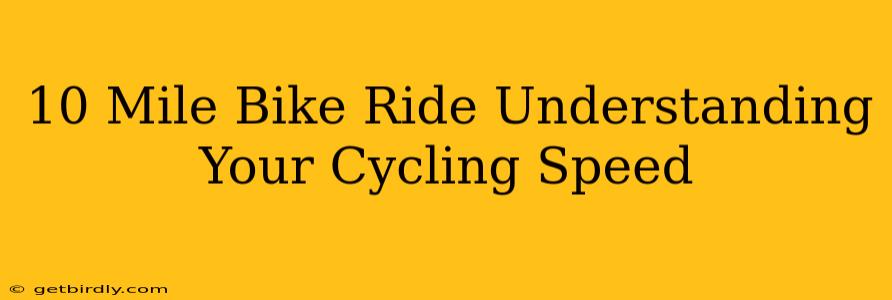10-Mile Bike Ride: Understanding Your Cycling Speed
A 10-mile bike ride is a great distance for assessing your fitness level and understanding your cycling speed. Whether you're a seasoned cyclist or just starting out, knowing your speed can help you track progress, set realistic goals, and improve your performance. This guide will break down the factors influencing your cycling speed and help you interpret your results.
What Determines Your Cycling Speed on a 10-Mile Ride?
Several factors contribute to your cycling speed over a 10-mile distance. Understanding these factors can help you improve your time and overall cycling experience.
-
Fitness Level: Your cardiovascular fitness and leg strength directly impact your power output and endurance. Higher fitness levels generally translate to faster speeds.
-
Bike Condition and Type: A well-maintained bike with properly inflated tires will roll more efficiently than a neglected one. The type of bike also matters; road bikes are typically faster than mountain bikes due to their lighter weight and aerodynamic design.
-
Terrain: Hills, headwinds, and uneven surfaces significantly impact speed. A flat, tailwind route will be much faster than a hilly one with a headwind.
-
Gear: Appropriate gearing is crucial. Too high a gear will lead to exhaustion, while too low a gear will limit your speed.
-
Technique: Proper cycling technique, including efficient pedaling, body positioning, and cornering, can significantly improve your speed and efficiency.
-
Weight: A lighter rider will naturally have an advantage, requiring less energy to maintain speed.
How to Calculate Your Average Cycling Speed
Calculating your average speed for a 10-mile ride is straightforward:
Average Speed = Total Distance / Total Time
For example, if you complete a 10-mile ride in 45 minutes (0.75 hours), your average speed is:
10 miles / 0.75 hours = 13.33 mph (miles per hour)
Remember to convert your time to hours for accurate calculations. Most cycling computers or fitness trackers will automatically calculate this for you.
What is a Good Average Speed for a 10-Mile Bike Ride?
There's no single "good" average speed for a 10-mile bike ride. It heavily depends on the factors mentioned above. However, here's a general guideline:
- Beginner: 8-12 mph
- Intermediate: 12-16 mph
- Advanced: 16+ mph
These are just estimates, and your speed can vary significantly based on individual circumstances. Focus on consistent improvement rather than comparing yourself to others.
How Can I Improve My Cycling Speed?
Improving your cycling speed involves a multifaceted approach:
-
Increase Training Intensity and Frequency: Incorporate interval training, hill climbs, and endurance rides into your routine.
-
Improve Bike Maintenance: Ensure your bike is properly tuned and maintained, including tire pressure, chain lubrication, and brake checks.
-
Optimize Your Gear: Choose the right gear ratios for your fitness level and the terrain.
-
Refine Your Technique: Practice efficient pedaling, maintain proper body posture, and learn to navigate corners effectively. Consider lessons from a cycling coach.
-
Strength Training: Incorporate strength training exercises, particularly focusing on leg muscles.
What if I'm struggling to maintain a consistent speed on my 10-mile ride?
If you're finding it difficult to maintain a consistent speed during your 10-mile ride, consider these possibilities:
- Inadequate fitness: Focus on building a solid base of cardiovascular fitness and leg strength through regular training.
- Poor bike fit: An improperly fitted bike can lead to discomfort and inefficiency. Consider a professional bike fitting.
- Incorrect gearing: Experiment with different gears to find the optimal cadence and power output for various terrains.
- Lack of nutrition and hydration: Ensure you're properly fueled and hydrated before, during, and after your ride.
How can I track my progress over time?
Tracking your progress is vital for motivation and improvement. Use a cycling computer, fitness tracker, or even a simple notebook to record your ride times and speeds. Analyzing this data over time will help you identify trends, areas for improvement, and celebrate your achievements.
By understanding the factors affecting your cycling speed and implementing strategies to improve, you can enjoy the satisfaction of consistently improving your performance over your 10-mile bike rides. Remember that consistency and patience are key to making significant progress.

